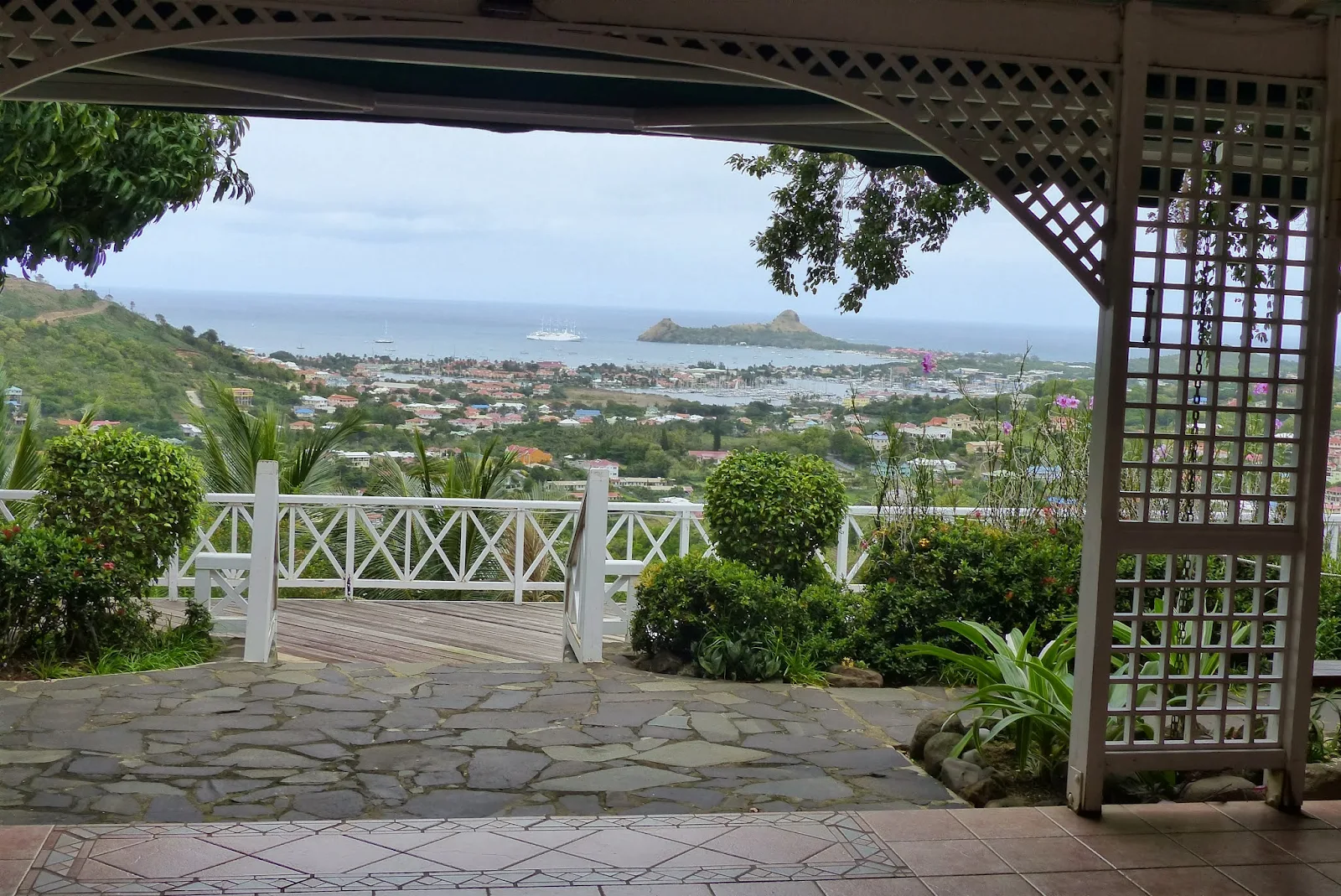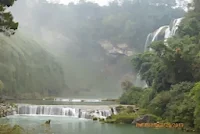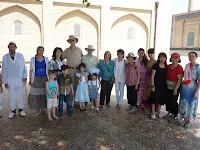Four days in Yogyakarta (Yogya for short and first y is pronounced as a j) were enough to form some impressions about Indonesia. The roads we traveled on were by and large in good shape though some in the countryside can be quite narrow and for this reason favored smaller, narrower foot print cars. Especially in the city, the streets swarmed with motorbikes. I guessed that for every car, there might be 10 mopeds and the like but our guide thought the ratio was closer to 25 to 1. Most of the scooters and mopeds looked less than 3 years old, perhaps an indicator of the recent improvements in the Indonesian economy. Most people, particularly in the city, wore helmets when they rode or drove the motor bikes. Ironically, young children rode sandwiched between their parents and usually were without helmets.

Despite varying degrees of aggressiveness among the drivers, the traffic was fairly orderly. We did not witness any road rage or arguments and did not see any traffic collisions. In general the people were friendly to each other and to foreign visitors. I believe the gentleness of Javanese culture fosters harmony among the people far more successfully than say the Chinese culture has.
It’s no surprise that Indonesia, being a nation of archipelagoes, has many ethnic people and many local languages. Bahasa is the national language that was created in the 1930’s by revolutionaries as part of the attempt to unify the chain of islands that was to become the nation of Indonesia. The language apparently borrowed a lot from the Dutch and looked easy to learn. Some words were naturally intuitive such as gratis, polisi (police), taksi (taxi), apotek (pharmacy). Other words, we saw so often that we can figured out what they meant, for example, masuk (enter) and keluar (exit), nasi goreng for fried rice and mie goreng for chow mein.
Day 1
We left Singapore in the midst of a huge tropical storm. The Air Asia flight was only a few minutes late. Yogyakarta airport did not have gates that connect directly to the terminal but we alit on the tarmac and walked into a small entry to go through immigration. Buying the visa on arrival was actually a shorter line than the line for foreigners carrying passports with visas already in them. On the spot tourist visa at $25 per person was also cheaper than getting it ahead of time in America. Mr. Herry, our guide, was late getting to the airport so that a momentary panic was creeping in when he showed up. I had just gotten a new HTC Droid phone and did not really know how to use it yet and was trying to call Mr. Herry when he appeared.

Prambanan temple complex was located near the airport, both east of Yogya. The temple complex was restored from rubble of gray volcanic rocks that we were to see a lot of during this visit. Volcanic rocks being the most available were used to erect temples, unfortunately without any binders. The tongue and groove method of constructions proved unable to resist the shaking from the movement of the faults over the centuries. While the volcanoes provided the building material, the earthquakes destroyed the man-made structures leaving piles of rocks for puzzle loving archeologists to solve.
From Prambanan, we headed west into the city of Yogyakarta to the Phoenix Hotel. Phoenix was located near the center of town but not in a very interesting neighborhood. The hotel itself was interesting from an architecture point of view, converted from a previous British estate.
Day 2
We got up at 3:30 AM in order to be picked up at 4 to see the sunrise at Borobudur. The sunrise tour was available exclusively through the Manohara Resort Hotel situated next to the site. The tour included a give-away flashlight for each person and tea or coffee with pastries afterwards.

We could have selected a tour that included staying at the Manohara and sleep an hour longer. The other advantage was that the temple was just a short walk away and hotel guests could then go to the Borobudur at any time at no extra admission charge. For anyone thinking of seeing only Borobudur and not stay in the area for more than 2 nights, Manohara would have been an appealing option.

We were not rewarded with a spectacular sunrise as we took the dawn trek up the terraced temple site but we did enjoy the serenity of the morning calm undisturbed by any throng of noisy tourists—which we were to meet on our way down. From the top of Borobudur, we watched the post-dawn fog rolled into the valley providing a veil over the hillside and the light from the sun behind the clouds gradually giving definition to sculptures of sitting Buddha in various poses of meditation.

On our descent, we made partial circles of each terrace to enjoy the artistry of sculptured stone panels. On the very bottom terrace, Mr. Herry told us to go clockwise from the east gate to see the beginning-to-end portrayal of Ramayana, the classic Hindu epic of good vs. evil, abduction and rescue, heroic battles and heart breaking suspicion of marital infidelity.
In line with the Borobudur were two other small Buddhist temples that we stopped briefly to see. Be they Hindu or Buddhist, the temples were uniformly gray due to the use of volcanic rocks. The differences in style were subtle and the casual tourist would be tempted to dismiss them in the mold of “seen one, seen them all.”
From Borobudur we drove back to Yogya and headed for the Sultan’s Palace and then the Water Palace where once the Sultan and his many wives cavorted. The Sultan’s palace was in part a museum and in part the living quarters of the current and 10th Sultan and his family (off limits to visitors). We were told that the Sultan’s father (the 9th) joined the struggle for independence from the Dutch early on and at one time served as the vice president of Indonesia when Suharto reigned as president for life. The tenth is the current governor of the province that has Yogya as the capital.

Our guide also took us to a batik making factory and show room and then to a silver shop called Ansor in the southern part of the city. Both were located in upscale neighborhoods.
We got back to our hotel shortly after noon but it already seemed like a long day for us. We walked to a nearby Chinese restaurant for a late lunch. We ordered mie gorang (chow mein) along with chicken with vegetable and pork with pickled vegetables. We must have been hungry and felt that we didn’t have enough to eat and supplemented with an order of nasi gorang (fried rice).

Food was inexpensive in Indonesia while beer was comparatively more pricey though still cheap compared to US prices. For dinner last night and lunch today, we ate for less than the equivalent of ten dollars but a large bottle of beer cost about $3.
We were supposed to see a performance of the Ramayana ballet tonight. We ended up in traffic gridlock and Herry saw that we were not going to make it on time. He quickly cleared with his boss and changed our attendance to the following night. Even then turning around and getting out of the traffic was a challenge. The driver of the car obstructed by our driver’s attempt to make a U turn on a narrow two-lane road quickly got out of his car to halt traffic so that our driver could complete the maneuver smoothly. Nobody honked but waited patiently. We found out later that there was a chemical fire near the theatre that had caused the traffic congestion.
Day 3
We didn’t have to leave quite so early but it was still a 7:30 AM departure. We were heading for Dieng Plateau, about 3.5 hours away. Along the way, we came to a farmer’s market on a small village half way up the mountain. At the lookout point, our next stop, someone spoke to May first in English to find out if she spoke Chinese and then broke into Mandarin. They are overseas Chinese apparently many generations in Indonesia but still they felt so proud of China’s achievement and talked wistfully of visiting China someday.
The ostensible object of our tour today was the oldest known Hindu temple complex dating back to 5th century AD and only restored in 2008. This temple complex was on a much lesser scale than Prambanan and couldn’t justify a trip on its own merit. On the plateau we then came to scalding hot springs and Lake Warna, known for multi-colored water in a scenic setting. On the way home, we stopped at a roadside restaurant known for their satay for a real cheap meal. By chance a parade celebrating a mass circumcision of boys coming of age (10) and their families riding in horse carts came by.

The designated boys dressed in white were being honored and unaware that they were about to encounter the first traumatic experience of their young lives.
Tonight we attended the Ramayana ballet that we missed the previous night. It was lightly attended, consisting of one Japanese tour group and one European tour group along with a handful of others, altogether may be 40 in the audience. It was colorfully costumed and appeared to be well done. We were given an English description of the story so that it was easy to follow along. The actors/dancers were good at catching arrows shot at them across the stage, that and one of the actors rolling on a trough of fire added color to the performance.
Day 4
This was another early morning departure at 7 AM. About an hour later, we were at the slopes of the Merapi volcano, youngest of 11 active ones on Java at about 150 million years old. Herry showed us the bunker where two foreign journalists were baked to death during the eruption of 2004, when the lava flow went right over the bunker.

After some roadside photo stops, we went into Solo, also known as Surakarta (pop. 900,000), a much newer and more modern city than Yogya (pop. 600,000). Our first stop was to see the Sultan’s Palace, where the ninth, 58, still lived there with his second wife and kids. His first wife was a daughter of Sukarno. Not being an early supporter of independence, he did not become governor of his province.
The palace was nicely kept up since the Sultan still lived inside with his immediate family. As our guide explained, the sultan still ruled inside the palace grounds. The visitor can take photos on the grounds and inside the first reception hall but not inside the next room, which doubled as former throng room and a museum of the sultan’s memorabilia. There were some priceless jewelry and other objects of art, but it was poorly displayed in dim lighting that greatly detracted from the appeal.
After the palace tour, we went to a nearby Chinese restaurant for lunch. The owner came to speak Chinese with us. One of his sons was cutting swatches from rolls of material. The material is for an apparel factory that he also runs, he explained.
We had fried whole fish, sautee’d soft shell crab, spinach and chow mein, plus beer and tea for under $14 but nearly took all the Rupiahs in my wallet. The ATMs in Indonesia worked very nicely. Usually the maximum amount one can withdraw at one time was one million Rupiahs. I was to feel like a millionaire about three times while in Yogya.
After lunch, we went to see the antique market, said to be the largest in Java. The shop owners did not seemed to be doing much business and made only half hearted attempts to entice us into their stores. We probably look too much like tourists and not like serious buyers.
Nearby was the so called Solo’s Chinatown. It consisted of one large complex that looked like any farmers’ market selling fresh produce, fruits, meats, herbs, and other sundries. Across the way, sandwiched between two larger buildings was a Chinese temple. The temple was undergoing renovation, especially being painted. The smell of paint persuaded us not to tarry.
Day 5
We got up early in the morning again to catch a 7 AM AirAsia flight back to Singapore. One thing our guide forgot to tell us was airport departure tax, which was 100,000 Rupiahs per person. I thought I had carefully and cleverly spent every one of my Rupiahs the night before only to having to make a last minute change of my Singapore dollars to pay for the departure tax.
Reflections:
Judging from a scarcity of bicycles on the road (but numerous new scooters and mopeds) and relatively few beggars on the streets, I have the impression that Indonesia’s current government is working effectively and the country is on a trajectory of economic growth. However, we did not see modern high rises. Pedicabs out-numbered taxis and most restaurants were not air conditioned. Therefore Indonesia does not appear to be on the verge of an economic boom like that of China.
Historically, Java had its share of powerful kingdoms but apparently never one strong enough to take control of the entire island and perpetuate a culture and language that would endure. Consequently, the people of Java do not enjoy an institutional memory of the glory days of old. Borobudur, Prambanan and other edifices are man-made wonders without the benefit of human records and thus remain enigmas for generations to ponder.
Getting there: AirAsia offers non-stop flights between Singapore and Yogyakarta. Other airlines connect via Jarkarta and turn the 2 hour flight into a much longer proposition. Everything with this no-frills airline is a la carte. You can prepay your meal and be the first ones to eat and you are charged for checked baggage depending on the weight (free for one carry-on plus one personal handbag). By booking well in advance, I got two round trip tickets for around US$350, meals included.












































